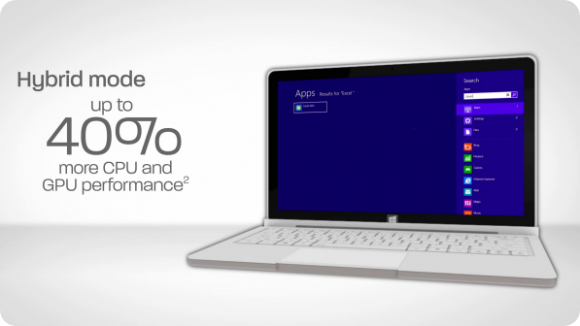I wrote about AMD Temash yesterday at Ultrabooknews but it’s a solution that reaches into ultra mobile PC space too and it means I have to write two articles!
Although it’s an Ultrabook-class processor, it’s down-clocked, has a Turbo feature and sits in the 4-6W TDP range. It’s an SoC too so this solution now becomes a very interesting competitor to both Clovertrail and Ivy Bridge. It’s possible to get Ivy Bridge into a tablet see the Surface Pro but AMD Temash, like the Fusion solutions that were introduced for Netbooks, seems better positioned.
Take a look at the article over at Ultrabooknews which highlights the new performance figures for the platform and shows the new ‘dock’ feature. The dock allows the Temash platform (actually only the AMD A6 1450 at the moment) to overclock when it is docked. We don’t have a feel for battery life advantages yet although there’s mention of a new lower-power state and advanced ‘gating.’
Unfortunately AMD haven’t gone the whole way to provide an external PCI bus and higher-power discreet graphics in the dock but maybe the GPU in Temash is already powerful enough. It certainly competes with the HD 4000 in Ultrabooks.
I’ll be at MWC next week so I’ll have a change to get more details on Temash and Temash-based products.
It’s good to see competition in the Windows 8 mobile CPU space.
Source: Ultrabooknews












I don’t agree with under clocking a system unless the external battery pack is docked, I believe that the user should be able to make the decision wheter or not to burn the battery life of the system when performance is required.
I never liked idea of underclocking the device in tablet mode and then normal speeds in docked mode. I much prefer some sort of extremely dynamic performance/power states in any mode.
As Marauderz said, it should be the user who chooses. Maybe have options/profiles for determining when the clock speeds and voltages increase when docked or undocked. For example, load duration, CPU percentage or some more high level options that controls more complicated algorithms.
While I agree with the sentiment, it’s not something they can allow easily because there are physical limitations imposed by tablet design.
Essentially, it’s not just a matter of power efficiency but also thermal tolerance range and heat dissipation efficiency.
Since tablets are designed to be as thin and as light as possible, but this makes them harder to cool.
Most mobile tablets get away with passive cooling only because they use very little power and thus generate very little heat.
Mind also that the Turbo mode for this product more than doubles the max TDP to about 14W and that definitely requires active cooling!
So one of the reasons for the dock requirement is also because the dock provides additional cooling with built in fans, as well as the extra power provided by the secondary battery in the dock.
Otherwise, the system could easily overheat long before the battery run out…
Though, while docked, you should be able to choose performance/power options…